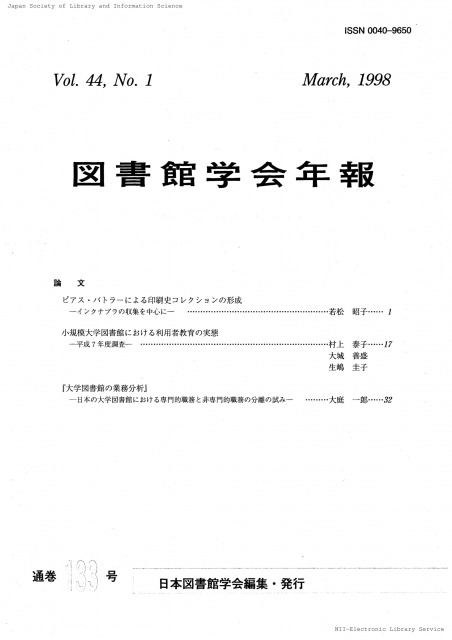All issues

Volume 36 (1990)
- Issue 4 Pages 149-
- Issue 3 Pages 97-
- Issue 2 Pages 49-
- Issue 1 Pages 1-
- Issue Supplement Page・・・
Volume 36, Issue 4
Displaying 1-6 of 6 articles from this issue
- |<
- <
- 1
- >
- >|
Article
-
Shoichi TANIGUCHIArticle type: Article
1990 Volume 36 Issue 4 Pages 149-166
Published: 1990
Released on J-STAGE: November 10, 2021
JOURNAL FREE ACCESSIn the area of descriptive cataloging an object (a bibliographic item) has been grasped traditionally from two aspects, one physical, the other intellectual. Though this framework for grasping an object is useful within a certain scope, it cannot cope effectively with new problems which have arisen in the area. Therefore an alternative framework is required at present. A 3-layered model as such a framework is proposed in this paper.
First a 2-layered model is constructed as an attempt. Each layer of the model corresponds to each aspect of the traditional framework. One layer is termed “book” and the other is “work”.
Secondly some issues which have been discussed in the area are reviewed critically in terms of the above 2-layered model, and then the problems contained in the model are extracted.
Thirdly a 3-layered model is introduced in place of the 2-layered model for the purpose of giving a solution to the problems. This model consists of “medium”, “text” and “work”. “Text”, which means a string of words and other symbols, was first proposed by P. Wilson. And finally an attempt to cope with the problems concerning microform reproductions and computer files is made by using the 3-layered model.View full abstractDownload PDF (2751K) -
Takako AKABOSHIArticle type: Article
1990 Volume 36 Issue 4 Pages 167-182
Published: 1990
Released on J-STAGE: November 10, 2021
JOURNAL FREE ACCESSIMAZAWA Jikai (1882-1968) was one of the leaders of early Japanese public libraries. He had been the librarian and the director of the Tokyo Metropolitan Library, from 1908 to 1931. He is also well known as one of the pioneers who introduced the ideas and practices of English and American children's librarianship to our country, through many writings and translations, as well as by the activities in his own library.
The purpose of this paper is, to find the influences of the Anglo-American children's librarianship on his ideas, by examining his writings and comparing them to the original foreign texts.
Among his writings on the library service for children, we found many common principles with Anglo-American ideas, that were written in the books by Arthur Bostwick and W.C. Berwick Sayers etc. But he selected what is necessary according to his own thought and adapted them to fullfill the needs of the contemporary Japanese socio-cultural background of his time. On some points, he was more liberal than his Anglo-American forerunners in the field, for instance, in respect to children's spontaniety in the library and, lower age children's admission to the public library. It is hard to find the differences between his ideas and today's ideal library services for children, except for the education and the training of children's librarians, on which he had hardly discussed his philosophy. If his ideas had been developped and realized continuously up to now, without being interrupted by World War II, the present situation of children's librarianship in Japan might be more favorable in many ways.View full abstractDownload PDF (2544K)
-
Kazuhisa OKUIZUMI1990 Volume 36 Issue 4 Pages 183-193
Published: 1990
Released on J-STAGE: November 10, 2021
JOURNAL FREE ACCESSThe library movement of the Young-Men's Associations was originally a self-intiated and self-sustaind movement. However, in order to match the changes that were brought about in Japanese society after the war, the library movement underwent a change in direction based upon the requests and needs of the national government.
After the war, the activities of Young-Men's Associations libraries all over the country were expanded under the slogan “The improvement of morality” but those activities were in reality a reflection of the government's policy, which was to solve the problem of youth through improving the order of society by means of moral education, thereby promoting the growth of nationalism.View full abstractDownload PDF (1738K)
-
1990 Volume 36 Issue 4 Pages 194-1-
Published: 1990
Released on J-STAGE: November 10, 2021
JOURNAL FREE ACCESSDownload PDF (133K) -
1990 Volume 36 Issue 4 Pages 194-2-196
Published: 1990
Released on J-STAGE: November 10, 2021
JOURNAL FREE ACCESSDownload PDF (386K)
Summary
-
Article type: Summary
1990 Volume 36 Issue 4 Pages 197-198
Published: 1990
Released on J-STAGE: November 10, 2021
JOURNAL FREE ACCESSDownload PDF (162K)
- |<
- <
- 1
- >
- >|